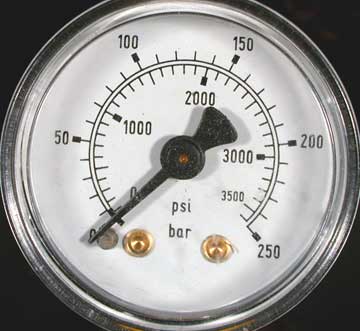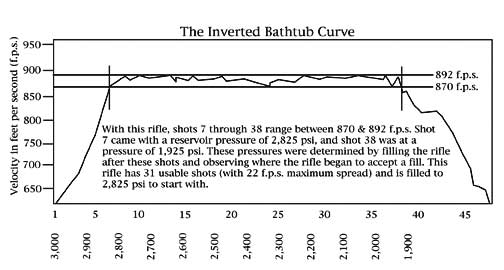by Tom Gaylord
Copyright PyramydAir.com ©2009. All Rights Reserved.
Here's some info that every PCP shooter should know. The first part is about high-pressure air vessels. The second part deals with something I call the "bathtub" curve of performance.
Under Pressure
If you want to use precharged pneumatic airguns, you ought to know something about air pressure and how it works. Instead of the scientific definition, let's speak plainly. A bar may be thought of as one unit of atmospheric pressure. The time-honored explanation of one atmosphere of pressure, which is supposed to be the pressure at sea level on a "standard day," is approximately 14.5 pounds per square inch (psi). That number is only theoretical, since air pressure varies constantly all over the world and there is actually no place on earth where the sea is level. But by using a convenient number like this, we can discuss air pressure. So, one bar (from the Greek word baros, which means weight) is one atmosphere or 14.5 psi.
Then, 200 bar is equal to 14.5 x 200 or 2,900 psi. Airgunners and divers round this off and say that 200 bar equals 3,000 psi, which is one standard pressure to which scuba tanks may be filled. More precisely, 3,000 psi is around 206.8 bar.
So, when you hear that an airgun operates on 300 bar, you now know how to convert that to psi. And the answer is 4,350 psi. We typically round this up to 4,500 psi.
Why it matters
Air pressure can wear out a pressure vessel through the simple expansion and contraction of the vessel walls. You know, for example, that a rubber balloon eventually fails from being inflated and deflated many times. If you don't know it, get a balloon and see how many times you can inflate it before it bursts.
The air pressure in a balloon is around 100 psi or less. What is the air pressure in a modern airliner? Much less, as it turns out. An airliner is pressurized to a certain pressure (equivalent to perhaps 8,000 feet above sea level), but if it flies at 40,000 feet, the air pressure on the inside is much greater than the pressure outside. Not so great as 1 whole bar, but due to the vast surface area of the airliner, tremendous expansion takes place when the plane ascends and contraction occurs when it descends. This works the metal in the airplane to a greater degree than almost anything else it encounters, so we speak of an airplane's life as measured by so many pressure cycles.
A scuba tank is much smaller than an airplane and can, therefore, hold more pressure. But, it also expands under pressure and contracts when the pressure is released. Every five years, a scuba tank must undergo a test that measures the remaining elasticity to determine if the tank should continue in service. After all, we don't want a scuba tank to pop like a balloon or an airplane--do we? In fact, a scuba tank explosion is so dangerous that the hydrostatic test is done with water rather than air. If there's a failure, the pressure drops instantly because water does not compress like air.

Air pressure can wear out a pressure vessel through the simple expansion and contraction of the vessel walls.
Smaller pressure vessels
Your airgun filler hoses are also pressure vessels while you use them. They have a very small surface area, so they can take a lot of pressure; however, air hoses are not made as robust as scuba tanks. Microbore air hoses are even smaller inside, so they can take even higher pressure; plus, when they're bled to disconnect from the gun, not as much air is lost. All air hoses are built to take some multiple of their standard operating pressure and, yes, they do blow up from time to time--as do scuba tanks, balloons and airliners.

A manometer (pressure gauge) for airguns commonly reads both psi and bar.
The Bathtub Curve

Let's explore a common phenomenon--the inverted bathtub curve. This phenomenon helps you set up your PCP airgun to get the greatest number of shots with the least amount of deviation. You will need an accurate chronograph to do this.
All PCP airguns lose air pressure with each shot. The air valve exhibits a tendency to compensate for the pressure loss by remaining open an instant longer as the pressure drops. The valve spring initiates the closing of the valve, but the internal air pressure of the reservoir is what actually closes and seals the valve. How fast it does it is a function of many things:
Buy With Confidence
Get FREE shipping on qualifying orders! Any order $150+ with a shipping address in the contiguous US will receive the option for free ground shipping on items sold & shipped by Pyramyd AIR during checkout. Certain restrictions apply.
Free shipping may not be combined with a coupon unless stated otherwise.
View Shipping Info
We work hard to get all orders placed by 12 pm EST out the door within 24 hours on weekdays
because we know how excited you are to receive your order.
Weekends and holiday shipping times will vary.
During busy holidays, we step our efforts to ship all orders as fast as possible,
but you may experience an additional 1-2 day delay before your order ships.
This may also happen if you change your order during processing.
View Shipping Times
It's important to know that due to state and local laws, there are certain restrictions for various products. It's up to you to research and comply with the laws in your state, county, and city. If you live in a state or city with regulations, you may be able to take advantage of our special FFL program.
U.S. federal law requires that all airsoft products be sold with a 1/4-inch blaze orange muzzle or an orange flash hider to avoid being mistaken for regulated products.
View Shipping Restrictions
Get the most out of your equipment when you work with the expert technicians at Pyramyd AIR. With over 25 years of combined experience, we offer a range of comprehensive in-house services tailored to kickstart your next adventure.
We can test and adjust your equipment in our Pro Shop before shipping, so you receive a product that's ready to perform right out of the box. We can even set up an optic or other equipment so you can get out shooting without the hassle. For bowhunters, our certified master bow technicians provide services such as assembly, optics zeroing, and full equipment setup, which can maximize the potential of your purchase.
By leveraging our expertise and precision, we ensure that your equipment is finely tuned to meet your specific needs and get you ready for your outdoor pursuits. So look out for our services when shopping for something new, and let our experts help you get the most from your outdoor adventures.
View Service Info
Shop and purchase with confidence knowing that all of our products (except airsoft) are protected
by a minimum 1-year manufacturer's warranty from the date of purchase unless otherwise noted on the product page.
A warranty is provided by each manufacturer to ensure that your product is free of defect in both materials and workmanship.
View Warranty Details
Didn't get what you wanted or have a problem? We understand that sometimes things aren't right and our team is serious about resolving these issues quickly. We can often help you fix small to medium issues over the phone or email.
If you need to return an item please read our return policy.
Learn About Returns
Get FREE shipping on qualifying orders! Any order $150+ with a shipping address in the contiguous US will receive the option for free ground shipping on items sold & shipped by Pyramyd AIR during checkout. Certain restrictions apply.
Free shipping may not be combined with a coupon unless stated otherwise.
View Shipping Info
Want More?
Join Our Email List for News and Deals!
Join the Pyramyd AIR mailing list: Our e-mails are filled with new products, deals, sneak peeks, tips and tricks, contests and more - sign up today!
Text JOIN to 91256 and get $10 OFF Your Next $50+ Order!
* By providing your number above, you agree to receive recurring autodialed marketing text msgs (e.g. cart reminders) to the mobile number used at opt-in from Pyramyd AIR on 91256. Reply with birthday MM/DD/YYYY to verify legal age of 21+ in order to receive texts. Consent is not a condition of purchase. Msg frequency may vary. Msg & data rates may apply. Reply HELP for help and STOP to cancel. See Terms and Conditions & Privacy Policy.